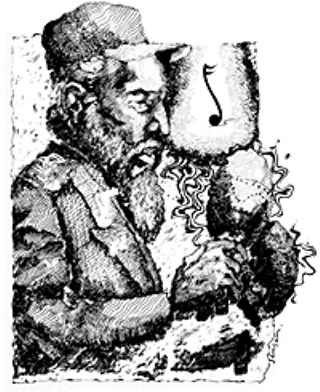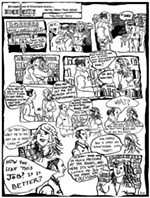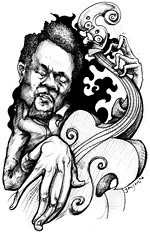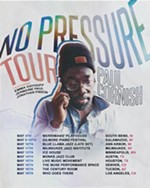Cubana Be Cubana Bop
A Historical Guide to Cuban Music
By Harvey Pekar, Fri., Jan. 12, 2001

Partly owing to the popularity of Wim Wenders' 1999 movie Buena Vista Social Club, there's been quite a bit of recent international interest in Afro-Cuban music. Unfortunately, it seems to be confined mainly to the artists who appeared in the film and the Forties and Fifties styles they perform. Some are great performers, others never were. What drew public attention to them was that most were older, had been in the Cuban music scene during the pre-Castro days, and then were pretty much forgotten.
Certainly their situations contain some gripping drama, but the extraordinarily rich Cuban music scene has produced many great artists over the past 70 years and continues to do so. Moreover, the decades-long creative exchange between Cuban and American jazz musicians is still going on today. Those who love what Cuban music they've heard but have a limited overall knowledge might want to familiarize themselves with more of its past as well as what's happening right now.
Cuban music began to make an international impact in the 19th century, such as the habañera from Bizet's Carmen. The son, blending elements of Spanish and African balladeering, is generally thought to have originated in the rural regions of Cuba's Oriente province. Many pieces called rumbas over here were actually sones, including "El Manicero," a big hit in the early Thirties, under the name "The Peanut Vendor." Louis Armstrong's version could be thought of as an early example of Latin jazz.
Son groups were originally composed of vocalists, string (tres guitar), and percussion players, including someone to set the basic rhythm on claves; call-and-response patterns were frequently employed. When sones made an impact in Twenties Havana, the size of son groups grew. Ignacio Pinter's Septeto Nacional included Pinter on bass and Lazaro Herera on trumpet for Ignacio Pinero and His Septeto Nacional (Tumbao).
Further advances were made by the blind tres player/composer Arsenio Rodriguez and his conjunto, a group that grew out of black carnival bands. Rodriguez's music was earthy and hard-driving, with strong African elements. Some believe he was among the first to use the Congolese-influenced mambo in clubs, along with bassist Israel "Cachao" Lopez, who gained attention in charanga bands containing flute and violins. Cha-cha-chas were popularized by charanga bands such as Orquestra Aragon.
Arsenio Rodriguez's band performed a variety of material, some written by Rodriguez, including son montunos, boleros, and guaguancos. Usually employing a lineup of two trumpet players, a conga player, a pianist, tres, guitar, and other percussion instruments, it featured a number of major instrumentalists over the years. Trumpeter Felix Chappotin (born 1909) could be looked upon as the Louis Armstrong of Cuban trumpeters, a powerful, economical soloist who effectively used trills, grace notes, and rips.
Another Rodriguez trumpet alumnus was Alfredo "Chocolate" Armenteros, who later became quite prominent in the United States. The Cuban trumpet style owed something to both the Spanish sounds heard in bullrings and military-band playing. Cuban improvisers, including trumpeters and other instrumentalists as well as vocalists, used syncopation and rhythmic dislocation frequently; their work was very complex and sophisticated.
Rodriguez also had two major pianists in Ruben Gonzales (of Buena Vista fame), who never recorded with him, followed by Lili Martinez. These two, along with Pedro "Peruchin" Justiz, were among the founders of the percussive, colorful Afro-Cuban piano style: bright, flashy chordal work and dazzling parallel and contrary motion. Rodriguez was himself a superb tres player who superimposed counter-rhythms over the rhythm section and used advanced harmonic ideas. Dundunbanza (Tumbao) shows his band in top form.
Once Rodriguez left for New York, Chappotin took over the band, and continued Rodriguez's tradition with a series of excellent albums showcasing the powerful, rhythmically precise vocalist Miguelito Cuni. A highlight is Chappotin's Que Se Funan (Musica del Sol). Meanwhile, momentous things were happening to Cuban music in America. Mario Bauza, a bass clarinetist in the Havana Symphony, switched to trumpet and moved to the U.S. after playing with such highly regarded Cuban artists as Antonio Machin and Don Azpiazu.
Once in America, Bauza performed in the big bands of Noble Sissle, Chick Webb, Don Redman, and Cab Calloway from 1932-1941. A section mate of his in the Calloway band was Dizzy Gillespie. The two discussed the possibilities and potential of blending jazz and Afro-Cuban musical forms with Calloway, and soon were conducting exciting experiments synthesizing the two genres.
Bauza became the music director of Machito's band in 1941, and brought a multitude of ideas from big-band swing arrangements into the vocalist's charts. Gillespie formed a big band in 1946, and in 1947 hired Cuban percussionist/vocalist/composer Chano Pozo to work for him on some notable recordings for RCA Victor, including "Cubana Be Cubana Bop" and "Manteca."
Around the same time, Machito was featuring bop greats Howard McGhee (trumpet) and Brew More (tenor sax) during his New York appearances. Their music soon became known as Afro Cubop. Later, Charlie Parker and Gillespie made memorable recorded appearances with Machito's band. The charts they used, by Cuban composer Chico O'Farrill, can be heard on The Original Mambo Kings (Verve). Stan Kenton was also fusing Afro-Cuban and jazz elements at about the same time as Gillespie. The wedding of jazz and Afro-Cuban elements has flourished ever since, eventually giving rise to the genre known as Latin jazz.
In 1953, jazz pianist George Shearing formed a band with a great Latin percussion section featuring Willie Bobo on timbales, Mongo Santamaria on congas, and bongo player Armando Perazza, along with Swedish-American vibrophonist Cal Tjader. The band was quite popular, although it often used excessively refined cocktail lounge-type arrangements, and can be heard on Shearing's Latin Escapade (Capitol).
After leaving Shearing, Tjader continued to explore Latin jazz, and at one time had Bobo and Santamaria working for him simultaneously, as during Latino Con Cal Tjader (Fantasy). The two percussionists had both worked for Tito Puente, whose charts often had a strong jazz quality. During the mid- to late Fifties, it became common for Latin and jazz musicians to work side by side and develop considerable abilities in both areas. During this period, the mambo was extremely popular, and many American musicians played in bands led by Latinos.
Santamaria went on to develop a tri-hybrid style blending jazz, Latin, and R&B elements, as did percussionist Ray Barretto, who also appeared on many jazz and charanga dates. Barretto's Acid (Fania) is considered a fusion classic. Santamaria's hit "Watermelon Man" is available on Mongo's Greatest Hits (Fantasy).
Not all Latin/jazz fusion was going on in the U.S. In 1952, the great Cuban pianist Bebo Valdez led a group through several recorded improvised numbers called descargas (jams) in Havana. His band included perhaps the greatest Cuban trumpeter, Alejandro "El Negro" Vivar, who blended Gillespie's approach and the more traditional Cuban style wonderfully.
Also in Valdez's band was tenor saxophonist Gustavo Mas, a fine, Lester Young-influenced improviser whose work was reminiscent of Moore's. The result was electrifying, irresistibly infectious music. More recorded descargas by Valdez followed during the next five years, with not only Vivar but also the top-notch trombonist and arranger Generoso "El Tojo" Jimenez, available on Valdez's Descarga Caliente (Caney). Cachao also led some memorable descarga sessions on which Vivar appeared. Cuban Jam Session Vol. 2 (Panart) is a fine place to start, with selections by his group and Julio Gutierrez's.
Cuban musicians were also paying attention to Machito's big-band experiments. Beny More, often considered the greatest Cuban popular vocalist and a wonderful improviser whose ebullient singing resembled Cab Calloway's, formed a superb band, the Banda Gigante. Jimenez was More's primary arranger, and he and Vivar were featured soloists. More and his aggregation are in excellent form on Baila Mi Son (Caney).
When Fidel Castro came to power, the flow of Cuban musicians to the United States was drastically reduced. Puerto Rican artists, both those born on the island and in the New York area (Puente, Barretto, Tito Rodriguez, Eddie and Charlie Palmieri, Manny Oquendo) moved to the forefront in the Big Apple. Cuban artists, for their part, kept abreast of developments in the U.S. without missing a beat.
Cuban band Irakere began gaining international acclaim in the Seventies. Far from being unaware of what was going on in the U.S., its individual members exhibited the influence of contemporary jazzmen. Musical director (and son of Bebo) Chucho Valdez, a tremendous technician with a working knowledge of jazz, Latin, and classical forms, was influenced by McCoy Tyner. Clarinetist, alto, and soprano saxophonist Paquito D'Rivera's playing indicated he was aware of the work of Eric Dolphy and Cannonball Adderley.
D'Rivera was also classically trained, while guitarist Carlos Emilio Morales had a fusion style, and high-note specialist Arturo Sandoval was an admirer of Gillespie. Irakere drew ideas from several sources and put them together in a new way. Their album, The Best of Irakere (Columbia), makes it obvious Cuban music was evolving significantly in the Seventies.
In fact, Irakere's predecessor, Orquestra Cubana de Musica Moderna, was formed in 1967 and included not only Valdez, but also the phenomenal trombonist Juan Pablo Torres. Torres is musical director on the memorable Areito All Star recordings, cut in 1979 by Raoul Diamande, an Ivorian producer based in France.
Diamande thought Cuban artists weren't getting enough attention, so he set up this date, on which veterans including Ruben Gonzalez, Chappotin, and Cuni played alongside younger guys such as Torres, D'Rivera, and Sandoval to great effect. Gonzalez's work is far better than his Buena Vista appearance, because he was younger and playing more frequently.
Prior to the Buena Vista recordings, American producer Joe Boyd had gone to Havana to record a Cuban all-star band, Cubanismo, assembled and led by trumpet star Jesus Alemany. Their Hannibal recordings, although more traditional than Irakere's, are full of fire and precision. A recent disc with New Orleans musicians, Mardi Gras Mambo, also comes together nicely.
Among the major Cuban artists to emerge in the Nineties is pianist Gonzalo Rubalcaba, whose tremendous chops, knowledge of various genres, and ability to blend them are reminiscent of Valdez's. Rubalcaba doesn't always work within an Afro-Cuban context, also making straight-ahead jazz recordings with bassist Charlie Haden and the avant-garde Blue Note disc Flying Colors with Joe Lovano. Another of Rubalcaba's very advanced Blue Note efforts is Antigua, on which he skillfully makes use of electronic effects.
Cuba has an extraordinary musical heritage -- especially in view of its small population -- and in all probability will continue to produce outstanding singers and instrumentalists. As Rubalcaba's work shows, they are hardly standing still. Many influences are currently weighing on Cuban music, e.g. global DJ culture as well as American jazz and hip-hop. As rich as Cuba's musical past is, how much of the island's native characteristics its music retains in the future is anyone's guess. ![]()








